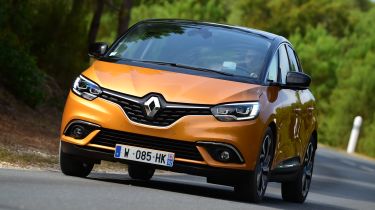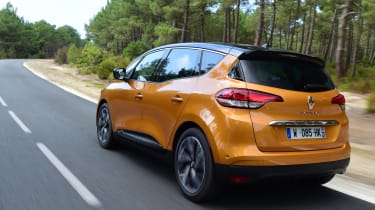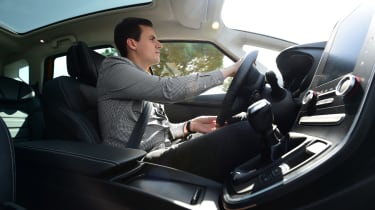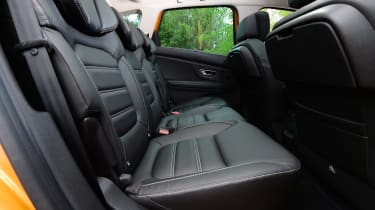New Renault Scenic 2016 review
It's make-or-break time for the new Renault Scenic - can its style and practical cabin steer buyers away from SUVs?

Renault has breathed new life into the Scenic. It’s safer, more practical and better to drive than its predecessor, with greater tech levels to boot. Some rivals are more spacious in the back, however, and while the petrol engine is good, we suspect a diesel would be a better fit. It remains to be seen if the bold new Scenic can tempt buyers out of their crossovers, though.
We're forever being told that SUVs are where the smart family car buyer now goes, and Renault knows that as much as anyone, as it has built the Captur and Kadjar to cash in. But unlike rival firm Peugeot, which has abandoned the MPV format with its new 3008 and 5008 crossovers, Renault isn’t putting all of its eggs in one basket just yet. That’s because it has launched this, the all-new Scenic.
As before, it’s available in five-seat form and seven-seat Grand Scenic guise, and the new model arrives 20 years after the original made its debut. Yet this is arguably the most important version of Renault’s MPV ever; design boss Laurens van den Acker has even gone so far as to say that if this car doesn’t sell, the segment “deserves to die”.
Used - available now

2023 MINI
Cooper Electric
22,248 milesAutomaticElectric
Cash £12,687
2021 Nissan
Leaf
17,471 milesAutomaticElectric
Cash £11,387
2022 Citroen
e-C4
27,861 milesAutomaticElectric
Cash £12,987
2020 Ford
Focus
17,904 milesManualPetrol1.0L
Cash £14,400It’s a bold statement that’s reflected in the fairly radical styling overhaul for the Scenic. Gone is the upright, bulbous design of the old car, replaced by a new face inspired by the Kadjar crossover and a rakish windscreen angle. The Scenic is longer and wider than the car it replaces, but it sits lower, while the pronounced kink in the shoulder line is a styling detail we’re used to seeing in hatchbacks and saloons, not MPVs.
Those huge 20-inch wheels aren’t an expensive extra, as Renault has made them standard across the range, although it claims that the tyres are no wider or pricier than the rubber you get for 16-inch wheels. The Scenic even has some crossover influences, thanks to the plastic cladding on the lower body. To our eye, the newcomer looks great, and it gives the futuristic Citroen C4 Picasso a run for its money on design.
Inside, the look is more restrained. The dash layout is similar to that of the new Mégane, which is unsurprising given that the cars share the same platform. There’s lots of dark plastic on the dash and doors, but the Scenic feels airy thanks to the stretched windscreen and our car’s optional panoramic roof. It doesn’t really feel like you’re sat in an MPV – you can thank the relatively high driving position and more driver-focused cockpit design for that – while material quality has come on in leaps and bounds over the last car, too.
This Signature Nav model gets a centre console that’s dominated by an 8.7-inch portrait-style touchscreen that controls most of the Scenic’s functions, while lesser trims get a slightly smaller version with fewer features. However, even base Expression models, which will start from just over £19,000, come loaded with kit, and top-spec cars feature items like a Bose stereo, head-up display, full LED headlights and electric leather seats.
• Best MPVs and people carriers
The new Scenic isn’t just a pretty face, though, as it has more cabin space than its predecessor. In five-seat mode there are 572 litres of boot space; in comparison, the Citroen C4 Picasso has 530 litres. Slide the rear seats forward and you get up to 720 litres, while the Grand Scenic is bigger still. Neat touches include rear seats that fold electrically from a panel in the boot, or you can operate them via the touchscreen on the dash. Space up front is great, but it’s a shame the middle row only splits 60:40. Head and legroom feel tighter for six-footers than in a C4 Picasso, too.
Given the Scenic’s size, a raft of new features and its safety systems (which give it a five-star Euro NCAP rating), it’s no surprise that it’s no lighter than the outgoing model. Even so, on the road it feels agile and composed. The wider track keeps body roll largely in check, and the steering is accurate, although push hard and things do feel softer and less grippy than in the Mégane.
Our biggest concern is the Scenic’s ride. On smooth French roads it felt firm but not uncomfortable, but we suspect those large wheels will be an issue on rough tarmac. Road noise is surprisingly unobtrusive, though, while wind noise is only noticeable at higher speeds.
There’s a choice of one petrol with two power outputs, a 1.6-litre diesel with four outputs, and even a mild-hybrid diesel. Our test car was the more powerful 1.2 TCe 130 petrol. It’s a strong enough engine, with reasonable refinement around town, a flexible mid-range and a willingness to rev. It’s not fast or exceptionally efficient, though, so buyers looking for load-lugging torque and stronger economy figures may prefer a mid-spec diesel. But whichever engine you choose, the Scenic comes across as oneof the better cars in its class to drive.










